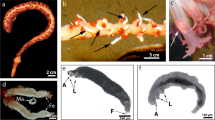Abstract
Specimens of the mesoparasitic barnacle, Anelasma, were found attached to several host deep-sea squaloid sharks, Centroscyllium fabricii from off Greenland, Etmopterus princeps from the Canary Islands, and Etmopterus unicolor and Etmopterus granulosus from Three Kings Ridge and Louisville Ridge near New Zealand. One to three parasites were partially embedded in each host shark in the head, mouth, bases of 1st and 2nd dorsal fins, pectoral and pelvic fins, caudal fin, abdomen or claspers. Testes and claspers of parasitized mature-sized males were less developed than those of non-parasitized mature males. The ova of parasitized females of mature size were small and whitish-yellow compared to the large yellow ova of non-parasitized mature females. The number of mature ova in a parasitized specimen was lower than expected in relation to a non-parasitized individual of the same size. Attachment of parasitic barnacles appeared to retard the development of reproductive organs of host sharks.
Similar content being viewed by others
References cited
Baer, J.G. 1951. Ecology of animal parasites. University of Illinois Press, Urbana. 224 pp.
Benz, G.W. 1987. Dermophthirius penneri n. sp. (Monogenea: Microbothriidae) an ectoparasite of carcharhiniid sharks, Carcharhinus brevipinna and Carcharhinus limbatus. Proc. Helminthol. Soc. Wash. 54: 185–190.
Caira, J.N. 1990. Metazoan parasites as indicators of elasmobranch biology. pp. 71–96. In: H.L. Pratt, Jr., S.H. Gruber & T. Taniuchi (ed.) Elasmobranchs as Living Resources: Advances in the Biology, Ecology, Systematics, and the S(2): 18–20.
Compagno, L.J.V. 1984. Sharks of the world. FAO species catalogue, vol.4, Part 1, FAO Fish. Syn. 125. 249 pp.
Fernándes-Ovies, C.L. 1995. Crustáceos parásitos sobre tiburones bentopelágicos del talud continental Asturiano. 2. Anelasma squalicola (Loven) (Cirripedia: Thoracica: Anelasmatidae). Bol. Cien. Nat. R. I. D. E. A. 43: 7–14.
Frost, W.F. 1928. The nauplius larva of Anelasma squalicola (Lovén). J. mar. biol. Ass. U.K. 15: 125–128.
Hickling, C.F. 1963. On the small deep-sea shark Etmopterus spinax L., and its cirripede parasite Anelasma squalicola (Loven). J. Linn. Soc. Zool. 45(303): 17–24.
Hoggrarth, D.D. 1990. The effects of parasitism by the rhizocephalan, Briarosaccus callosus Boschma on the lithodid crab, Paralomis ganulosa (Jacquinot) in the Falkland Islands. Crustaceana 59: 156–170.
Long, D.J. & B.M. Waggoner. 1993. The ectoparasitic barnacle Anelasma (Cirripedia, Thoracica, Lepadomorpha) on the shark Centroscyllium nigrum (Chondrichthyes, Squalidae) from the Pacific sub-Antarctic. Systematic Parasitology 26: 133–136.
Newman, W.A. & B.A. Foster. 1987. Southern hemisphere endemism among the barnacles: explained in part by extinction of northern members of amphitropical taxa? Bull. Mar. Sci. 41: 361–377.
Reinhard, E.G. 1956. Parasitological reviews: parasitic castration of crustacea. Exp. Parasitology 5: 79–107.
Shirai, S. & K. Nakaya. 1990. Interrelationships of the Etmopterinae (Chondrichthyes, Squaliformes). pp. 347–356. In: H.L. Pratt, Jr., S.H. Gruber & T. Taniuchi (ed.) Elasmobranchs as Living Resources: Advances in the Biology, Ecology, Systematics, and the Status of the Fisheries, NOAA Tech. Rep. NMFS 90.
Yano, K. 1986. Studies on morphology, phylogeny, taxonomy and biology of Japanese squaloid sharks, order Squaliformes. Ph.D. Thesis, Tokai University, Shimizu. 335 pp (in Japanese).
Yano, K. 1993. Distribution and food habits of the slender smoothhound, Gollum attenuatus, from the waters around New Zealand. Japan. J. Ichthyol. 39: 345–356.
Yano, K. 1995. Reproductive biology of the black dogfish, Centroscyllium fabricii, collected from waters off western Greenland. J. mar. biol. Ass. U. K. 75 285–310.
Yano, K. 1997. First record of the brown lanternshark, Etmopterus unicolor, from the waters around New Zealand, and comparison with the southern lanternshark, E. granulosus. Ichthyol. Res. 44: 61–72.
Yano, K. & S.Tanaka. 1989. Hermaphroditism in the lantern shark Etmopterus unicolor (Squalidae, Chondrichthyes). Japan. J. Ichthyol. 36: 338–345.
Author information
Authors and Affiliations
Rights and permissions
About this article
Cite this article
Yano, K., Musick, J.A. The Effect of the Mesoparasitic Barnacle Anelasma on the Development of Reproductive Organs of Deep-sea Squaloid Sharks, Centroscyllium and Etmopterus. Environmental Biology of Fishes 59, 329–339 (2000). https://doi.org/10.1023/A:1007649227422
Issue Date:
DOI: https://doi.org/10.1023/A:1007649227422




